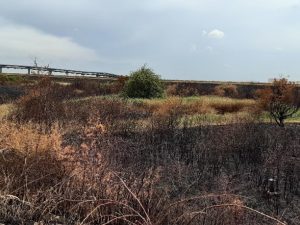…blog by Jo Loman, Buglife Canvey Wick Community Warden
It’s fair to say this summer has been an absolute scorcher! The newspaper headlines declare record high temperatures and droughts throughout the UK. Here in the south east of England, where our Canvey Wick reserve is situated, the Met Office has reported rainfall at less than 10% of usual levels for last month. This has resulted in the driest July since 1935 and the impact on the reserve can be clearly seen in these photographs. The vegetation is dried, brown and crispy with even the Hawthorn shrubs having lost all trace of green.

These extreme conditions, that are an indication of what we will increasingly face in future, are a challenge for wildlife that struggle to find food and moisture. It also heightens the risk of fire in these precious havens for invertebrates and other wildlife. This season, there have been a spate of outbreaks at Canvey Wick where the fire has spread rapidly through this dry fuel and at incredibly intense temperatures. It has been a tough time for the reserve team and it is certainly disheartening to see the large areas of the nature reserve and Site of Special Scientific Interest that have been affected.
Obviously, the big concern is around how our invertebrate populations respond to this additional stressor, and whether the emergent vegetation will be adaptive species that dominate the landscape, or if it returns to a lovely variety of wildflowers and grasses. To record how the vegetation responds to these events and to monitor the transition, fixed point photography has been set up to capture the regrowth in the areas affected by the fires. The first picture below was taken shortly after the fire and demonstrates the effectiveness of the mown wildflower corridor which acts as a fire break to stop the spread of the flames. A few weeks later the second picture shows lush green regrowth sprouting through the ashes. It is truly remarkable to see how quickly plants respond to such disastrous events.


It is of paramount importance to monitor the invertebrates and how vulnerable species are faring. There are pockets of habitat on the site that have survived unscathed and recent surveys by the Bumblebee Conservation Trust have found a number of specimens of the scarce Shrill Carder Bee (Bombus sylvarum) and Brown-banded Carder Bee (Bombus humilis).


It is still early days in the recovery process, and we remain concerned about the impacts of fires on Canvey Wick, but it’s uplifting to see how resilient nature is. Of course, not all species respond the same and it will require close attention to ensure the habitat develops in a way that supports our outstanding invertebrate residents. Let’s be hopeful for a positive outcome for Canvey Wick.
Have you read our other Canvey blogs? If not, why not take a look.
Visit our Canvey Wick webpage for more information about the reserve and it’s history.